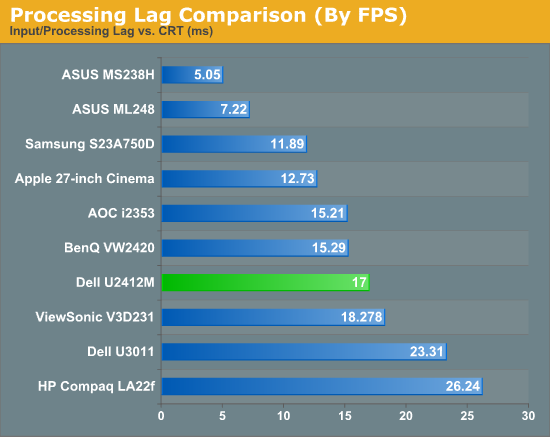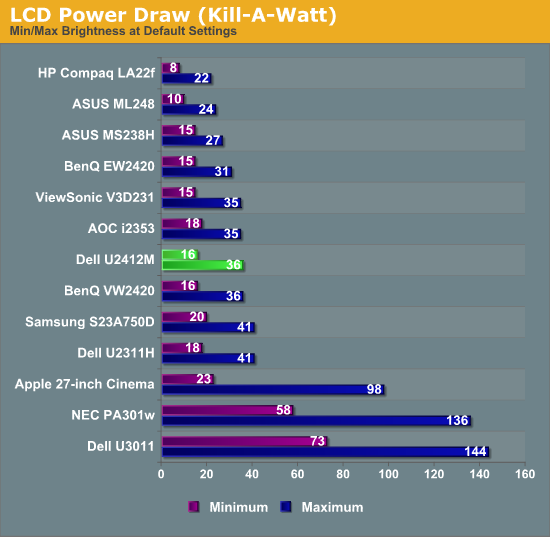Dell U2412M - 16:10 IPS without Breaking the Bank
by Chris Heinonen on February 28, 2012 9:00 AM ESTDell U2412M Input Lag and Power Use
For testing lag, I am trying a new solution to our previous testing method. I’m trying out SMTT, which is designed specifically for measuring lag in LCD displays. Using DirectX it manages to push over 1,000 frames per second to a display, allowing for millisecond accuracy instead of relying on time demos that often run well below that threshold. Using this method, we can actually determine two different values: The input lag for the LCD to initially respond, and then the total lag from when the new frame is received to when it is completely drawn and at full brightness. This last one is the overall important value, as it is what gamers would be most concerned with. It’s important to have as low an "input lag" as possible so that even if the screen isn’t fully drawn yet (the pixels will be changing over) you will be able to begin to get that feeling of responsiveness.

Here we see that the overall lag value measured OK, at 17ms. The input lag, which was also measured, was just under 2ms, which indicates that the Dell responds very quickly, and then it’s just a matter of the pixel response time. One thing to keep in mind here is that the 17ms response time is the total time from input to peak brightness, and then it takes 15ms to fall back to another value. When I actually look at the test subjectively and not objectively, you can certainly see the change in the pixel after 7-8ms of time. So I could report it as 8ms of lag, as that’s about what I think you would experience in a real world situation, but the worst case scenario seems to be 17ms, which is what I’m choosing to report as that’s the objective number.
The CRT still comes in perfect, and that’s what the LCD should aim to do; picking a number that gives a better result, even if it might be more applicable to the real world, feels like cheating. Perhaps we will get a future display technology (like OLED or CrystalLED that I saw at CES this year) that will bring us back to CRT response times, but until that happens I’m going with the objective, worst case measurement. I will report the “real world estimate” along with it, though, so you can use that for your own judgment. Please let me know what you think of this in the comments section.
I made the assumption that with a larger panel and the 300 nits of light output that the Dell would not be the most eco friendly panel I had seen. Happily I found this to not be the case. It drew just 36 watts at maximum brightness and only 16W at minimum brightness, less than even the 23” Dell U2311H from last year. I don’t know if it is more efficient LED lights, or a more transparent panel that allows more light through, but Dell did a good job keeping the power use low on the U2412M.











143 Comments
View All Comments
fausto412 - Tuesday, February 28, 2012 - link
Monitor Calibration and ReviewsI see all these monitor reviews where the monitor is calibrated for most accurate colors and blacks and all that...how does a person who bought the monitor go about getting it calibrated? are there local places who do this stuff? when they do it do they save the calibration on your screen?
cheinonen - Wednesday, February 29, 2012 - link
For calibrating the display you need a colorimeter or spetrometer and software. Most include some sort of PC software, or you can use something like DispCalGUI for free. Since these involve using the LUT in your video card, you can't have it done somewhere and then bring it back home, though you could borrow/rent hardware to get it done most likely.For testing, I use an i1Pro for the calibration, which runs around $1,000 new, and an i1DisplayPro for testing the black level (around $300) since it is more accurate at reading low levels of light, but worse at measuring colors. You can use something as simple as an i1DisplayLT, though it will start to drift over time and after 2-3 years you can't rely on it to be accurate anymore and would have to buy another one. The Colormunki series has a spectro that is pretty cheap for use with a monitor, but a cheap spectro is still $400-500 or more.
ggathagan - Wednesday, February 29, 2012 - link
If the big box stores were smart, this is the kind of service they would offer : in-home monitor/TV calibration using a customer's actual setup.hechacker1 - Wednesday, February 29, 2012 - link
They do, THX calibration and whatnot, but they charge an insane amount. Basically, it's better to just buy the colorimeter and do it yourself with various software.It's a good investment if you have many screens. Once you have it, it's a pain to work on any non-calibrated monitor, knowing just how bad it is.
Confusador - Tuesday, February 28, 2012 - link
"...still, I thought the explanation on the previous page would be useful for everyone."It was, thank you for keeping it in. It's always nice to know the rationale behind the testing method.
On a side note, I'm glad to see Dell at least trying to have a reasonably priced 16:10, but it still saddens me that we haven't seen much improvement in monitors (in terms of price/resolution) for so long. I can only dream that with high resolution tablets coming out, we'll see some of that trickle into desktops. For me at least, vertical space is at a premium because I have the horizontal covered by virtue of simply having more than one display.
Impulses - Wednesday, February 29, 2012 - link
I know right? Next gen tablets and phones are running higher resolutions than like 80% of laptops out there, and the average desktop display isn't faring much better. I don't see how market economics are allowing display manufacturers to create these amazing new 10" displays yet desktop displays have languished for so long...ggathagan - Wednesday, February 29, 2012 - link
I doubt you'll ever see that trend in discrete monitors.The entire reason for higher resolutions for a laptop/tablet is due to the physical constraints on the screen size.
If you want a higher resolution for a desktop monitor, you buy a larger monitor.
From a manufacturing standpoint, I would guess that quality control issues increase geometrically when you work with larger physical sizes. It's probably a lot easier to create a high resolution screen at 10 inches than it is at 24 or 27 inches.
Unless there's a compelling reason to do so, I doubt screen manufacturers are eager to take that on.
Far better to concentrate R&D efforts on 120Hz IPS panels and the like.
Zolcos - Wednesday, February 29, 2012 - link
One way you could improve this part of the review is to use the same chart method that you used for power draw -- each monitor having two bars, one for "real world" input lag and one for "worst case" input lag.toyotabedzrock - Wednesday, February 29, 2012 - link
No tests of how it handles color gradients?If we are to pay more for an IPS display then it needs to be 8bit.
MadAd - Wednesday, February 29, 2012 - link
1200 lines is a start, but am still waiting for the ultimate answer to a monitor upgrade24", 120hz, 1200 lines and displayport
is that too much to ask?